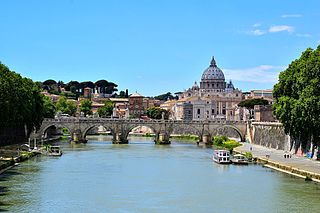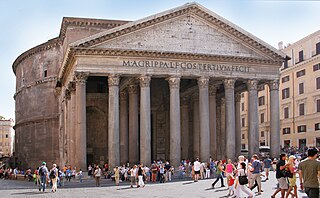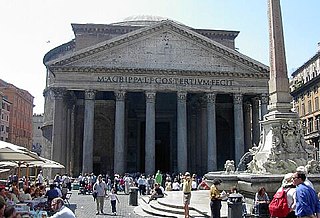
Classics or classical studies is the study of classical antiquity. It encompasses the study of the Greco-Roman world, particularly of its languages and literature but also of Greco-Roman philosophy, history, and archaeology. Traditionally in the West, the study of the Greek and Roman classics was considered one of the cornerstones of the humanities and a fundamental element of a rounded education. The study of classics has therefore traditionally been a cornerstone of a typical elite education.

Rome is the capital city and a special comune of Italy. Rome also serves as the capital of the Lazio region. With 2,872,800 residents in 1,285 km2 (496.1 sq mi), it is also the country's most populated comune. It is the fourth-most populous city in the European Union by population within city limits. It is the centre of the Metropolitan City of Rome, which has a population of 4,355,725 residents, thus making it the most populous metropolitan city in Italy. Rome is located in the central-western portion of the Italian Peninsula, within Lazio (Latium), along the shores of the Tiber. The Vatican City is an independent country inside the city boundaries of Rome, the only existing example of a country within a city: for this reason Rome has been often defined as capital of two states.

The Tiber is the third-longest river in Italy, rising in the Apennine Mountains in Emilia-Romagna and flowing 406 kilometres (252 mi) through Tuscany, Umbria and Lazio, where it is joined by the river Aniene, to the Tyrrhenian Sea, between Ostia and Fiumicino. It drains a basin estimated at 17,375 square kilometres (6,709 sq mi). The river has achieved lasting fame as the main watercourse of the city of Rome, founded on its eastern banks.

The 1st millennium BC is the period of time between from the year 1000 BC to 1 BC .
It encompasses the Iron Age in the Old World and sees the transition from the Ancient Near East to Classical Antiquity.

In classical antiquity, Illyria was a region in the western part of the Balkan Peninsula inhabited by a numerous tribes of people collectively known as the Illyrians. Besides them, this region was also settled, in various times, by some tribes of Celts, Goths and Thracians. Illyrians spoke Illyrian languages, a group of Indo-European languages, which in ancient times perhaps had speakers in some parts in southern Italy. The Roman term Illyris was sometimes used to define an area north of the Aous valley, most notably Illyris proper.

Veii was an important ancient Etruscan city situated on the southern limits of Etruria and only 16 km (9.9 mi) north-northwest of Rome, Italy. It now lies in Isola Farnese, in the comune of Rome. Many other sites associated with and in the city-state of Veii are in Formello, immediately to the north. Formello is named after the drainage channels that were first created by the Veians.

Neoclassicism is the name given to Western movements in the decorative and visual arts, literature, theatre, music, and architecture that draw inspiration from the "classical" art and culture of classical antiquity. Neoclassicism was born largely thanks to the writings of Johann Joachim Winckelmann, at the time of the rediscovery of Pompeii and Herculaneum, but its popularity spread all over Europe as a generation of European art students finished their Grand Tour and returned from Italy to their home countries with newly rediscovered Greco-Roman ideals. The main Neoclassical movement coincided with the 18th-century Age of Enlightenment, and continued into the early 19th century, laterally competing with Romanticism. In architecture, the style continued throughout the 19th, 20th and up to the 21st century.
The plebs were, in ancient Rome, the general body of free Roman citizens who were not patricians, as determined by the census. The precise origins of the group and the term are unclear, though it may be that they began as a limited political movement in opposition to the elite (patricians) which became more widely applied.

Classical antiquity is the period of cultural history between the 8th century BC and the 5th or 6th century AD centered on the Mediterranean Sea, comprising the interlocking civilizations of ancient Greece and ancient Rome known as the Greco-Roman world. It is the period in which Greek and Roman society flourished and wielded great influence throughout Europe, North Africa and Western Asia.

The Pantheon is a former Roman temple, now a church, in Rome, Italy, on the site of an earlier temple commissioned by Marcus Agrippa during the reign of Augustus. It was completed by the emperor Hadrian and probably dedicated about 126 AD. Its date of construction is uncertain, because Hadrian chose not to inscribe the new temple but rather to retain the inscription of Agrippa's older temple, which had burned down.

In historiography, ancient Rome is Roman civilization from the founding of the city of Rome in the 8th century BC to the collapse of the Western Roman Empire in the 5th century AD, encompassing the Roman Kingdom, Roman Republic and Roman Empire until the fall of the western empire.
The civilization began as an Italic settlement in the Italian peninsula, dating from the 8th century BC, that grew into the city of Rome and which subsequently gave its name to the empire over which it ruled and to the widespread civilisation the empire developed. The Roman empire expanded to become one of the largest empires in the ancient world, though still ruled from the city, with an estimated 50 to 90 million inhabitants and covering 5.0 million square kilometres at its height in AD 117.
The following outline is provided as an overview of and topical guide to classical architecture:

Segni is an Italian town and comune located in Lazio. The city is situated on a hilltop in the Lepini Mountains, and overlooks the valley of the Sacco River.

Late antiquity is a periodization used by historians to describe the time of transition from classical antiquity to the Middle Ages in mainland Europe, the Mediterranean world, and the Near East. The popularization of this periodization in English has generally been accredited to historian Peter Brown, after the publication of his seminal work The World of Late Antiquity (1971). Precise boundaries for the period are a continuing matter of debate, but Brown proposes a period between the 3rd and 8th centuries AD. Generally, it can be thought of as from the end of the Roman Empire's Crisis of the Third Century to, in the East, the early Muslim conquests in the mid-7th century. In the West the end was earlier, with the start of the Early Middle Ages typically placed in the 6th century, or earlier on the edges of the Western Roman Empire.

Since ancient times, Greeks, Etruscans and Celts have inhabited the south, centre and north of the Italian peninsula respectively. The very numerous Rock Drawings in Valcamonica go back to 8,000 BC, and there are rich remains of Etruscan art from thousands of tombs, as well as rich remains from the Greek colonies at Paestum, Agrigento and elsewhere. Ancient Rome finally emerged as the dominant Italian and European power. The Roman remains in Italy are of extraordinary richness, from the grand Imperial monuments of Rome itself to the survival of exceptionally preserved ordinary buildings in Pompeii and neighbouring sites. Following the fall of the Roman Empire, in the Middle Ages Italy, especially the north, remained an important centre, not only of the Carolingian art and Ottonian art of the Holy Roman Emperors, but for the Byzantine art of Ravenna and other sites.

Philhellenism and philhellene, from the Greek φίλος philos "friend, lover" and ἑλληνισμός hellenism "Greek", was an intellectual fashion prominent mostly at the turn of the 19th century. It contributed to the sentiments that led Europeans such as Lord Byron or Charles Nicolas Fabvier to advocate for Greek independence from the Ottoman Empire.

The Capitoline Museums is a single museum containing a group of art and archaeological museums in Piazza del Campidoglio, on top of the Capitoline Hill in Rome, Italy. The historic seats of the museums are Palazzo dei Conservatori and Palazzo Nuovo, facing on the central trapezoidal piazza in a plan conceived by Michelangelo in 1536 and executed over a period of more than 400 years. The history of the museums can be traced to 1471, when Pope Sixtus IV donated a collection of important ancient bronzes to the people of Rome and located them on the Capitoline Hill. Since then, the museums' collection has grown to include a large number of ancient Roman statues, inscriptions, and other artifacts; a collection of medieval and Renaissance art; and collections of jewels, coins, and other items. The museums are owned and operated by the municipality of Rome.

Rieti is a city and comune in Lazio, central Italy, with a population of 47,700. It is the capital of province of Rieti and see of the diocese of Rieti, as well as the modern capital of the Sabina region.

Italy has a very broad and diverse architectural style, which cannot be simply classified by period or region, due to Italy's division into several city-states until 1861. However, this has created a highly diverse and eclectic range in architectural designs. Italy is known for its considerable architectural achievements, such as the construction of arches, domes and similar structure during ancient Rome, the founding of the Renaissance architectural movement in the late-14th to 16th century, and being the homeland of Palladianism, a style of construction which inspired movements such as that of Neoclassical architecture, and influenced the designs which noblemen built their country houses all over the world, notably in the United Kingdom, Australia and the United States of America during the late-17th to early 20th centuries. Several of the finest works in Western architecture, such as the Colosseum, the Duomo of Milan, the Mole Antonelliana in Turin, Florence cathedral and the building designs of Venice are found in Italy. Italy has an estimated total of 100,000 monuments of all varieties. Now Italy is in the forefront of modernist and sustainable design with Architects like Renzo Piano and Carlo Mollino.

The Culture of Rome, Italy refers to the arts, high culture, language, religion, politics, libraries, cuisine, architecture and fashion in Rome, Italy. Rome was supposedly founded in 753 BC and ever since has been the capital of the Roman Empire, one of the main centres of Christianity, the home of the Roman Catholic Church and the seat of the Italian Republic. Due to its historical and social importance, Rome is often nicknamed the Caput Mundi, or "capital of the world".



















